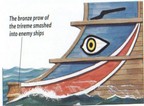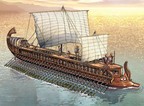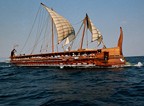Prior to circa 800BC there’s no leading ship type utilized within the fleets of the Aegean Ocean. Most of the vessels were little beyond than extended boats of an ancient design. They’re mainly used in war to carry troops and marine battles were planking actions. Circa eight hundred BC the force was intend and altered marine fights to a competition of manoeuvre and speed. At 1st this guide to the progress of the Penteconter, a smooth butt armed as well as quick war galley control by 50 oars, with 25 to a region and managed by 50 oarsmen.
A big Pentecontor might range up to thirty seven to thirty eight meters; the grin would be 4 meters to enable room regarding the rowers for working the oars. Such ships have a speed of nine to ten knots. Also there was a minute war galley, utilized in the marines of the Aegean Ocean. Circa seven hundred BC the Bireme was created when somebody came-up with the plan of utilizing outriggers. This enabled 2 rows of oars. The inferior rows of oars were fixed directly with the hull as well as operate exactly as they’d in earlier vessels. The upper row of oars were fixed with the outriggers as well as the higher oarsmen sit further external, giving area for both rows of oars to function. Biremes had a narrow beam comparing Penteconters of the similar length with most of them having a beam of 3 meters. Most of the Biremes carried hundred oarsmen.
The 1st Triremes were developed around 650BC and in 500BC the Trireme was the most extensively utilized bulky warship of Greek. In the Trireme now the outriggers were an essential segment of the vessel’s hull. Also the Trireme had a full or partial fighting ‘deck on top of the rowers. However, length of the Trireme remained nearly about thirty five to thirty meters, and the grin was about 3.5 meters. A Trireme carried one hundred seventy oarsmen, in addition 20 sailors as well as 14 marines within Greek fleets. The peak velocity of a Trireme was about 11.5 knots. Some Triremes might have been capable of reaching higher velocity in short ruptures.
A Trireme touring from the Athens to the Mitylene at 427BC made the three hundred fifty Km trip in just twenty four hours averaging 8 knots. The Trireme can accelerate much quicker than a Penteconter or Bireme, and was much more manoeuvrable. This offers the Trireme a benefit in battle where high speed and manoeuvrability meant a superior chance of success. The Trireme required a well trained as well as drilled squad of rowers, each person had to react to commands in unity. A solitary rower that unsuccessful to uphold the stroke can cripple the vessel’s fighting capability, so only liberated men can be utilized on Triremes. This supposed they’re costly to uphold, and it took time for training crews to the standard required for battle.
Greek Naval Strategy:
The Greek fleets depended on 2 major tactics, the periplus and the diekplus. The periplus was a comprehensive line utilized to outline the opponent and slam into his vulnerable faces. The diekplus was a manoeuvre of some difficulty and required exact timing and skilful rowing. The counteract was to shape more than 1 line and this was speedily modified. A distrustful tactic utilized throughout this time was the Kyklos.
Periplus:
Within the preiplus, the navy performing the red fleet backs water gradually in front of blue feet, keeping its shoves facing the opponent until the vessels on its borders could execute the periplus, allowing them to shove their opposition’s sides. In the other hand, the rest of the navy prevents backing water and go forward to attack. This’s the strategy that was utilized in the Battle of Salamis.
Diekplus:
In this manoeuvre, the quicker and more manoeuvrable fleet wants to break throughout the opposition’s line as well as bring a usual action which’ll offer it a plus. Guided by its flagships, it makes its move towards in line to the front. Then the red flagships, by speedily backing water on 1 side turn into an opposition and assisted by opposition’s own impetus sheer of its rows, leaving it powerless.
These ships were often used by Romans, as during second of the Caesar’s invasions in Britain. Bireme evolved in a trireme. The unit commandant (that was given the tent on open deck) and directed the group of marines. Bireme was been recorded in the ancient history at eighth century Assyrian reliefs. The medieval galleys are described as the “trireme” or “bireme” that depends on number of the banks of oars. Terminology will lead to the confusion, as terms are used for the rowed warships of Greco Roman time built on totally different principles. Initially it led to development of Penteconter (it means 50oared), the sleek ram armed & fast galley war power by 51, with 25 to the side & manned by 50 oarsmen. Also, there was the smaller war galley, Triaconter (it means 30oared) used in navies of Aegean Sea.
Around 700BC Bireme was developed while somebody came with an idea of using the outriggers. It allowed 2 tiers of oars. Lower tier of the oars were fitted straight to hull & operate like they had in the earlier ships. Upper tier of the oars were been fitted to outriggers & upper oarsmen sat outward and giving room for tiers of oars on work. The biremes had the narrower beam than the Penteconters of similar length having the beam of 3 meters. Most of the Biremes carried over 100 oarsmen. Greek warships had sails and oars. Biggest warships had 3 banks of oars as well as were called triremes. The trireme required 170 men row it – and one man to every oar. This had the long narrow deck, which soldiers can run along & fight from. Oarsmen sat below deck.


